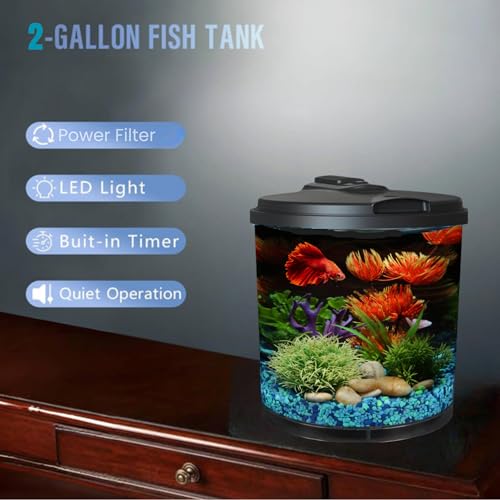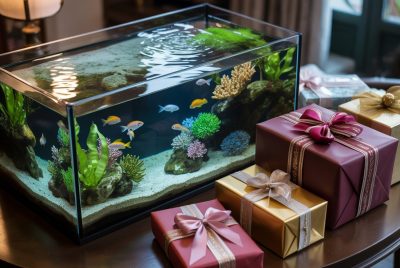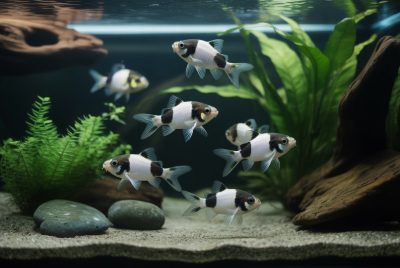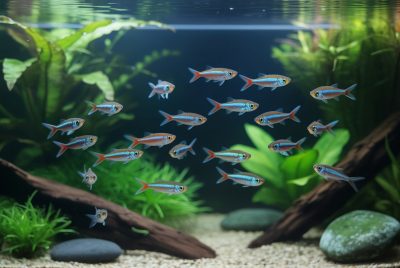Fish Tank Setup for Kids: A Parent’s Complete Guide
*We may earn a commission for purchases made using our links. Please see our disclosure to learn more.
The living room was chaos. Toys scattered everywhere, my seven-year-old bouncing off the walls with energy, and me desperately searching for something—anything—that might teach responsibility while capturing that restless attention. That’s when I stumbled upon the idea that would transform our home: setting up a fish tank for kids.
I’ll never forget the moment we brought home that first small aquarium. The excitement in those little eyes, the careful way tiny hands pressed against the glass, watching our new finned friends swim gracefully through their underwater world. What started as a desperate parenting move became one of our most rewarding family adventures.
“Fishkeeping is not just about maintaining an aquarium; it’s about nurturing life, learning responsibility, and discovering the delicate balance of aquatic ecosystems. For children, it’s often their first real lesson in caring for something beyond themselves.”
— Dr. Marine Biology Research Institute
Key Takeaways
Before diving into our fish tank journey, here are the essential points every parent should know:
- Start small: A 10-20 gallon tank is perfect for beginners and easier to maintain than tiny bowls
- Choose hardy fish: Goldfish, bettas, and guppies are forgiving for learning kids
- Involve kids in setup: Let them help with decorating and choosing (safe) accessories
- Create a maintenance routine: Daily feeding and weekly water checks teach responsibility
- Safety first: Secure all equipment and choose non-toxic decorations
- Budget wisely: Initial setup costs $100-200, with monthly maintenance around $20-30
Top 4 Fish Tank Setup for Kids Products
1. Tetra ColorFusion Aquarium 20 Gallon Fish Tank Kit
Bring your aquarium to life with the Tetra ColorFusion 20 Gallon Fish Tank Kit — a complete, vibrant setup perfect for beginners and kids alike. Featuring color-changing LED lighting, this kit creates a mesmerizing underwater display that can be paused on any color to suit your mood. It includes everything you need to get started: a 20-gallon glass tank, heater, Whisper 20 filter, colorful plants, a blooming anemone, and a secure hood. The flowing anemones and glowing décor provide both fun and functional hiding spots for your fish, creating a calming and playful environment.
Complete beginner aquarium kit with vibrant color-changing LED lights, a quiet filtration system, and playful décor that kids absolutely love. This fish tank setup for kids features a 20-gallon size—perfect for housing multiple small fish, making it an ideal first tank for young fish keepers. Easy to set up and fun to watch, it transforms any room into an exciting underwater adventure.
- All-in-One Kit: Includes filter, heater, LED lighting, and decorations for easy setup.
- Kid-Friendly Display: Color-changing LEDs create an engaging and customizable visual experience.
- Generous Size: 20-gallon capacity offers plenty of space for beginner fishkeeping.
- Limited Instructions: Setup manual may be too basic for complete beginners.
- Filter Noise: Whisper filter may produce noticeable sound in quiet rooms.
- Glass Weight: Tank is heavy and less portable once filled with water.
2. API Freshwater Master Test Kit
The API Freshwater Master Test Kit is a comprehensive and trusted solution for monitoring the health of your freshwater aquarium. With the ability to perform up to 800 tests, this kit includes everything you need: 7 bottles of testing solutions, 4 test tubes with caps, and a detailed color chart for accurate readings. It measures five critical water parameters—pH, high-range pH, ammonia, nitrite, and nitrate—ensuring your betta fish lives in clean, safe, and stable water conditions. Regular use of this kit helps prevent invisible water issues that can lead to stress, disease, or even loss of your fish.
An essential tool for any fish tank setup for kids—perfect for teaching water quality and responsible pet care while keeping fish healthy and thriving. The easy-to-read color charts make testing water simple, fun, and educational, turning science into a hands-on learning experience kids will actually enjoy.
- Comprehensive Testing: Covers all essential water parameters for freshwater tanks.
- Long-Lasting Value: Provides up to 800 tests, making it cost-effective over time.
- Accurate Results: Trusted by hobbyists and professionals for precise water readings.
- Manual Process: Requires measuring and comparing to color charts, which can be time-consuming.
- Storage Space: Comes in a relatively bulky box that may take up tank cabinet space.
- No Digital Display: Lacks digital convenience some modern testers offer.
3. Marina Betta Kit with LED Light (2.5 Gallon)
The Koller Products 2-Gallon Fish Tank is the ultimate beginner-friendly aquarium designed with kids and first-time fish keepers in mind. Made from durable, impact-resistant plastic with a crystal-clear view that rivals glass, this compact cylindrical tank includes everything needed to get started: a full hood, LED lighting with 7 vibrant color options, and a powerful internal filter to keep the water clean and clear. Ideal for bettas, guppies, neons, and ornamental shrimp, this easy-to-maintain setup adds a fun and calming touch to any room while teaching children responsibility and care for pets.
Perfectly sized for a single betta fish, this compact aquarium is an ideal fish tank setup for kids—especially younger children looking for a manageable and beautiful first pet. It offers a low-maintenance environment while adding a touch of color and charm to any bedroom or playroom. Kids can enjoy the calming presence of their fish while learning responsibility and animal care in a fun, engaging way.
- Beginner Friendly: Simple setup with built-in filter and LED light, ideal for kids and first-time owners.
- Vibrant Lighting: Choose from 7 LED color options to customize the tank’s glow and create a fun ambiance.
- Durable Design: Made of sturdy, leak-proof plastic that’s safer than glass for younger users.
- Small Size: Limited to a few small fish—may not be suitable for long-term use as fish grow.
- Battery-Powered Light: Requires AAA batteries or a separate power adapter sold separately.
- Plastic Build: Although clear, it may scratch more easily than glass over time.
4. Penn-Plax SpongeBob 6-Piece Mini Aquarium Ornament Set
Bring the magic of Bikini Bottom to your aquarium with the Penn-Plax Officially Licensed SpongeBob 6-Piece Mini Ornament Set! This colorful set includes fan favorites SpongeBob, Patrick, Sandy, Squidward, Mr. Krabs, and Plankton—perfect for kids and SpongeBob lovers of all ages. Made from safe, durable resin, each ornament is designed for both saltwater and freshwater tanks. The sturdy bases help keep them in place, and cleaning is as simple as a quick rinse. Whether in a fish tank, on a shelf, or used for decorating, these whimsical figures instantly add fun and character.
Kid-friendly aquarium decorations that are safe, vibrant, and full of personality—perfect for turning any fish tank into an exciting underwater adventure zone. These colorful characters spark imagination and make fishkeeping more fun for children, helping them feel connected to their tank and engaged in caring for their aquatic pets.
- Fun Factor: Brings SpongeBob’s world to life, sparking imagination in any aquarium.
- Fish-Safe Material: Made from non-toxic resin, safe for freshwater and saltwater tanks.
- Easy Maintenance: Ornaments clean easily with warm water—no soap needed.
- Small Size: Figures are mini (approx. 2"), so may look small in large tanks.
- Not Toys: For display only—may break if handled roughly by kids.
- Limited Detail: Simpler paint and design compared to high-end collectibles.
My Journey Into the World of Children’s Aquariums
When I first considered a fish tank setup for kids, I was overwhelmed. The pet store aisles seemed endless—filters, heaters, pH strips, water conditioners. How could something as simple as keeping fish be so complicated? But as I discovered, that complexity is exactly what makes aquariums such incredible learning tools for children.
The transformation didn’t happen overnight. Our first attempt was, frankly, a disaster. I bought the smallest, “easiest” tank thinking it would be simple. Three fish died within the first week. My child was heartbroken, and I felt like the worst parent ever. But that failure taught us both valuable lessons about patience, research, and the responsibility that comes with caring for living creatures.
The Emotional Journey: From Anxiety to Aquarium Confidence
Setting up our first successful fish tank was like solving a puzzle with my child as my enthusiastic assistant. We spent hours researching together, watching YouTube videos about the nitrogen cycle (simplified for a seven-year-old, of course), and planning our underwater landscape.
The magic moment came when we filled our properly cycled 15-gallon tank and introduced our first fish—three hardy goldfish we named after favorite cartoon characters. Watching my child’s face light up as those fish explored their new home was worth every moment of research and preparation.
Three Key Milestones That Transformed Our Aquarium Experience
1. The “Fish Tank Cycling” Revelation
Learning about the nitrogen cycle was our first major breakthrough. Initially, I thought you could just fill a tank with water and add fish immediately. Wrong! Teaching my child about beneficial bacteria and why we needed to wait several weeks before adding fish turned into an incredible science lesson.
We tested water daily, charting pH levels and ammonia readings like scientists. My child learned patience while watching invisible bacterial colonies establish themselves in our filter media. This waiting period, which initially felt frustrating, became a bonding experience as we prepared decorations and researched fish species together.
The hardest part was explaining why we couldn’t just “hurry it up.” But seeing the excitement when our ammonia levels finally dropped to zero, signaling a ready tank, was magical. We celebrated with a special dinner and counted down the days until fish shopping day.
2. Choosing the Right Fish: Hardy Species for Learning Minds
Our second major milestone was selecting appropriate fish. After our initial goldfish disaster in a too-small tank, we researched extensively. Goldfish, we learned, need more space than most people realize—at least 20 gallons for the first fish, then 10 additional gallons for each additional goldfish.
We decided on a combination approach: a 20-gallon community tank with colorful guppies, a few neon tetras, and one betta in a separate 5-gallon setup. The guppies were perfect for teaching about fish reproduction (we ended up with babies!), while the betta became a special responsibility for daily interaction and feeding.
Each fish species taught different lessons. The guppies showed us about social fish behavior, the tetras demonstrated schooling, and the betta taught us about territorial fish needs. My child learned to observe fish behavior, noting when someone seemed sick or stressed.
3. Establishing the Maintenance Routine
The third breakthrough was creating a sustainable maintenance routine that my child could mostly handle independently. We designed a chart with daily, weekly, and monthly tasks, complete with stickers for completed jobs.
Daily tasks included feeding (measured portions to prevent overfeeding) and a quick health check. Weekly tasks involved water testing and partial water changes. Monthly tasks included filter cleaning and decoration scrubbing. This routine taught time management, consistency, and the importance of regular care for living creatures.
The most challenging aspect was finding the balance between independence and supervision. Too much help, and my child wouldn’t learn responsibility. Too little, and the fish would suffer. We found our sweet spot with supervised independence—my child did the work while I watched and guided when necessary.
Common Challenges in Creating Kid-Friendly Aquarium Setups
Overfeeding Problems
Nearly every parent faces this challenge. Kids love feeding fish, and fish always seem hungry. We solved this by pre-portioning daily food into small containers, teaching that fish stomachs are tiny and overfeeding actually harms them.
Impatience with Water Changes
Weekly water changes can feel tedious to children. We made it fun by turning it into a science experiment, testing water parameters before and after changes, and letting my child operate the siphon (with supervision).
Equipment Safety Concerns
Aquarium equipment involves electricity and water—every parent’s nightmare combination. We solved this with GFCI outlets, secure equipment placement, and clear rules about never touching electrical components with wet hands.
Algae Growth Frustration
Green algae on glass drove my perfectionist child crazy. We turned cleaning into a game, using algae scrapers as “underwater window washing” and discussing how algae is actually natural and beneficial in controlled amounts.
Fish Loss Grief
Inevitably, fish die, and children form attachments. We handled this by having honest conversations about fish lifespans, holding small “ceremonies” for departed fish, and using these moments to discuss life cycles and caring for living things.
Essential Setup Components for Success
A successful fish tank setup for kids requires careful planning and age-appropriate equipment. Start with a tank between 10-20 gallons—large enough to maintain stable water conditions but small enough for children to manage. Include a quality filter rated for your tank size, as biological filtration is crucial for fish health.
Heating may or may not be necessary depending on your fish choice and home temperature. Goldfish thrive in cooler water, while tropical fish need consistent warmth. LED lighting makes the tank beautiful while supporting any live plants you might add.
For decorations, choose items specifically designed for aquariums. Avoid sharp edges, small parts that could be swallowed by fish, or items that might leach harmful chemicals. Plastic plants are easier than live ones for beginners, though live plants teach additional responsibility and help maintain water quality.
The Science Behind the Magic
Setting up a fish tank naturally incorporates STEM learning. Children learn biology through fish behavior observation, chemistry through water testing, physics through filtration systems, and mathematics through calculating feeding amounts and water change volumes.
We discovered that our aquarium became a living laboratory. My child learned about ecosystems, predator-prey relationships (even peaceful fish have hierarchies), and environmental balance. These lessons extended beyond the tank, fostering curiosity about natural water systems and environmental conservation.
The responsibility aspect cannot be overstated. Daily care routines teach commitment, while problem-solving sick fish or equipment issues develops critical thinking skills. Children learn that their actions directly impact other living creatures—a powerful lesson in empathy and responsibility.
Sensory-Rich Transformation: The Calming Effect
The gentle bubble of the filter, the soft glow of LED lights, the graceful movement of fish through crystal-clear water—our aquarium transformed our home’s atmosphere. What started as a learning tool became a focal point for family relaxation.
Evening fish watching became our wind-down routine. The calming effect on both children and adults was immediate and noticeable. Stress seemed to melt away as we observed our underwater community going about their daily activities.
The colors were mesmerizing—bright orange goldfish contrasting with electric blue neon tetras, vivid green plants swaying in the gentle current. The tank became a living artwork that changed throughout the day as fish moved through different areas and lighting shifted.
Overcoming Setup Obstacles
Our biggest obstacle was my own anxiety about “doing it wrong.” The internet is full of conflicting aquarium advice, and every expert seemed to have different opinions about the “right” way to keep fish. We overcame this by starting simple, focusing on basics, and gradually expanding our knowledge.
Budget constraints were real. Initial setup costs can easily spiral, but we learned to prioritize essentials over aesthetics. A basic tank, filter, and hardy fish taught the same lessons as an expensive setup. We upgraded gradually, making each addition a celebration of successful fishkeeping.
Space limitations in our home meant careful tank placement. We needed somewhere visible enough to encourage daily interaction but safe from household chaos. The dining room table wasn’t appropriate, but a sturdy stand in the living room corner worked perfectly.
Celebrating Small Wins in Aquarium Success
Every small milestone deserved celebration. The first successful week with all fish healthy meant ice cream. Successfully completing our first water change without spills earned a special aquarium decoration. Identifying and treating a minor fish illness (with veterinary guidance) was worthy of genuine pride.
We celebrated learning victories too—understanding why fish need different foods, recognizing signs of stress, or explaining to friends how our filter worked. These knowledge gains were as important as care achievements.
Photography became part of our celebration ritual. We documented our aquarium journey with pictures, creating a visual diary of our fish’s growth and our tank’s evolution. These photos became treasured memories of our shared learning adventure.
The Ripple Effect: How Aquariums Affected Our Family Life
Our fish tank journey influenced unexpected areas of our lives. My child became more observant, noticing details in nature that previously went unnoticed. Patience improved dramatically—waiting for tank cycling taught delayed gratification better than any lecture.
Academic performance improved in science subjects, with newfound interest in biology and chemistry. Environmental consciousness grew as we discussed water pollution’s effects on fish habitats. Responsibility in other areas increased as daily fish care became second nature.
Family dynamics shifted positively. We had a shared interest that sparked regular conversations. Problem-solving became collaborative as we researched solutions to aquarium challenges together. The tank provided a peaceful gathering spot for quality time without screens or distractions.
Words of Encouragement for Your Aquarium Journey
Starting a fish tank setup for kids might seem daunting, but remember that every expert aquarist started as a beginner. Your enthusiasm and willingness to learn alongside your child matter more than perfect technique. Fish are surprisingly resilient, and mistakes become learning opportunities rather than failures.
Don’t let perfectionist thinking prevent you from starting. Begin with hardy fish species, basic equipment, and simple maintenance routines. Complexity can come later as confidence and knowledge grow. The joy of watching your child develop genuine care for living creatures far outweighs any initial setup challenges.
Trust in your child’s capacity to learn and grow through this experience. Their natural curiosity and desire to nurture will guide them toward becoming responsible pet owners. The patience, observation skills, and empathy developed through aquarium keeping will serve them throughout life.
Your fish tank adventure awaits. Take that first step into the pet store, ask questions, start small, and prepare for a journey that will bring your family closer together while teaching invaluable life lessons. The underwater world is ready to welcome you both.
Frequently Asked Questions
Q: What’s the best age to start a child with their first fish tank?
A: Children as young as 5-6 can begin participating in fish care with heavy parental supervision, while 8-10 year olds can handle more independent responsibility. The key is matching expectations to your child’s maturity level and attention span.
Q: How much does it cost to set up a basic fish tank for kids?
A: Initial setup typically costs $100-200 for a complete beginner system including tank, filter, heater (if needed), decorations, and first fish. Monthly maintenance costs average $20-30 for food, water conditioner, and occasional replacements.
Q: What are the easiest fish for children to care for?
A: Goldfish, bettas, guppies, and neon tetras are excellent beginner fish. They’re hardy, colorful, and forgiving of minor care mistakes while children learn proper aquarium maintenance routines.
Q: How often do kids need to clean the fish tank?
A: Daily tasks include feeding and quick health checks. Weekly tasks involve partial water changes (20-25% of tank volume) and basic cleaning. Monthly deep cleaning includes filter maintenance and decoration scrubbing.
Q: Is it safe for young children to handle aquarium equipment?
A: With proper safety measures, yes. Use GFCI outlets, teach the “dry hands” rule around electrical equipment, and supervise all maintenance activities until children demonstrate consistent safe practices. Most daily care tasks like feeding are perfectly safe for children.
















